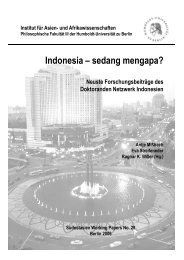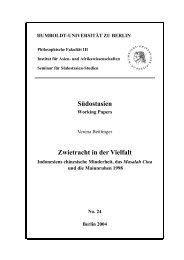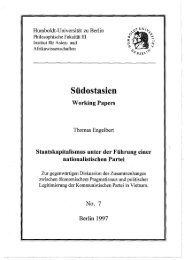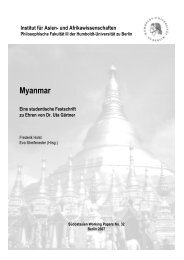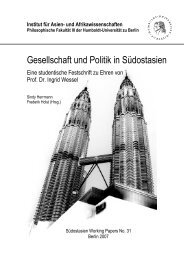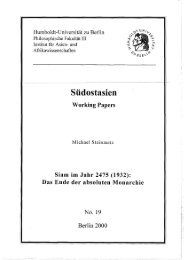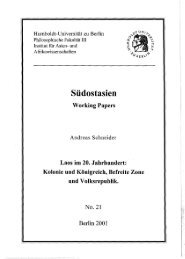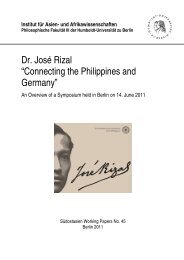On Centrism and Dualism - Humboldt-Universität zu Berlin
On Centrism and Dualism - Humboldt-Universität zu Berlin
On Centrism and Dualism - Humboldt-Universität zu Berlin
You also want an ePaper? Increase the reach of your titles
YUMPU automatically turns print PDFs into web optimized ePapers that Google loves.
CENTRISM AND DUALISM<br />
feature is the importance of the house as a focus of social organization. Taking a housecentric<br />
perspective might enable the analyst to resolve the ambiguities of kinship systems<br />
found in Indonesia, despite the tremendous variation in the scale <strong>and</strong> complexity of these<br />
societies (ibid. 47-48).<br />
This wide range of socio-political differences cannot be accommodated by traditional<br />
classificatory conceptions that consider egalitarian, ranked, <strong>and</strong> hierarchical societies as<br />
noncomparable; yet, in an anti-taxonomic approach they all can be better comprehended by<br />
examining the role of the house as a central fundamental organizing principle (GILLESPIE 2000b:<br />
43).<br />
Part of this ‘heuristic approach’ is the realization that houses are not always best considered as<br />
kinship or descent groups. Different scholars working on Southeast Asian societies noted that<br />
coherent <strong>and</strong> permanent social entities were better characterized as ritual <strong>and</strong>/or political units<br />
that may or may not coincide with kin-defined groups (cf. GILLESPIE 2000b: 45).<br />
This conclusion is linked to the main premise of CARSTEN <strong>and</strong> HUGH-JONES’ ‘heuristic<br />
approach’, according to which houses must be understood in their totality. In this approach,<br />
the house is symbolically linked to the cosmos, society <strong>and</strong> body, <strong>and</strong> the “language of the<br />
house” is thought to represent an alternative to the “language of kinship” (CARSTEN/HUGH-<br />
JONES 1995: 19). By the same token, houses must be viewed as living <strong>and</strong> developing entities<br />
just like the people who inhabit them. Accordingly, this view of the house is firmly grounded<br />
in indigenous conceptions. In much of the world, houses are believed to be endowed with<br />
spirits <strong>and</strong> souls, <strong>and</strong> they are conceived as living beings whose different parts often are<br />
labeled by the same terms as those given to human body parts (GILLESPIE 2000b: 47).<br />
II.1.2.3. Gillespie’s Conclusion<br />
After GILLESPIE has shown that the house – understood as a fetishization of conflicting<br />
principles – represents the starting point for most studies dealing with ‘house societies’ in<br />
Southeast Asia, she concludes her review of approaches to LÉVI-STRAUSS’ conception with a<br />
recommendation to safeguard his definition, rather than subsume the house of LÉVI-STRAUSS<br />
within the general rubric of a ‘language of the house’. 78 GILLESPIE states that many scholars<br />
have simply broadened or rejected LÉVI-STRAUSS’ definition, because it did not fit the<br />
particular society under investigation. Therefore, they would have lost the really important<br />
aspects of his conception (GILLESPIE 2000b: 47).<br />
78 Gillespie, solely, calls for the return to Lévi-Strauss’ original definition <strong>and</strong> not to the attached static notion of<br />
house as a classificatory type (GILLESPIE 2000b: 22).<br />
44



